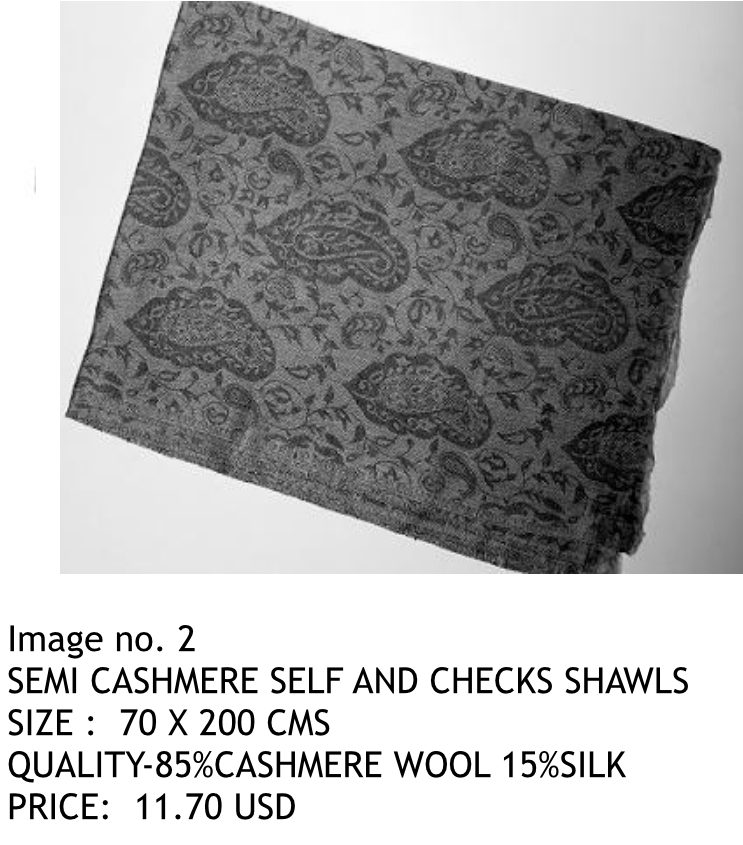In a previous article we discovered the traditional technique of kani weaving. What about counterfeits? This article details the differences between true and false kani. As for us, we are interested in the best way to track fake pashmina on the internet …
1 – The price
Always be wary of prices too attractive !!! A real kani shawl is trading US $ 1000 in Srinagar, the price then increases according to the number of intermediaries. An article too cheap will NEVER be authentic, the reciprocal is unfortunately not true …
2 – Jacquard weaving in tone on tone
This is my favorite method to recognize a machine-woven fake pashmina, and from there detect sites that lie about the quality of the product. The article presents patterns woven into the tone-on-tone frame that can not have been made by the human hand but are made by mechanical jacquard looms. As for the material it can vary from Mongolian cashmere to mixed lambswool or name to silk. The real pashmina of Ladakh is too fine to support the tension that the machine imposes.


3 – Examine the backside and curbs
Easier of course when you have the shawl under the eyes, but on the internet we have the resource to carefully examine the photos that we have at our disposal!
On the left a real kani shawl patiently woven for months. FYI the photo was taken from an online Indian site where it is marketed 2639 US $. The patterns of kani weaving are well recognized, as well as its fine and dense appearance. The back has just a little less sharp outlines.
On the right is an imitation machine-woven kani shawl. It is identical to the first glance, except for its backside that can be seen at the top of the photo: it seems blurry and rough with overthickness. This is what we recognize a false kani. The photo is bad and had to be zoomed to examine the offending area … Of course this would be much more obvious with the room in question before the eyes!
This style of fake pashmina is woven in the factories of Punjab, an Indian state south of Kashmir. For information, a stole machine-woven like the ones presented below – posted 380 € on the incriminated site – costs the purchase 15 US $ if it is in “pashmina” to know in fine wool of Australian sheep, or 35US $ cashmere from Mongolia. Even if the materials are natural, it remains a fake pashmina, a serial item, far from the real pashminas in Himalayan cashmere from Ladakh, hand-woven in Kashmir …
Some models woven in very fine wool maintain an almost perfect illusion to the place: it is then to examine the back and edges that are more rough. It becomes more and more difficult to detect trickery on the basis of a simple photo posted on a website …
Fake pashmina in kani weaving with very fine wool: in the place the illusion is almost perfect
So back to the shawl spotted by the client on a competing website: it is not a real pashmina but a serial article made by machine, wool, perhaps mixed silk or cotton, at best cashmere of Mongolia, the merchant remaining completely free to apply the margins he wants!
Following threats from the offending merchant site – Princesse Moghole being the reference of true pashmina in Europe this article had not gone unnoticed! – the photos extracted from this site with the proofs of the deception, had to be withdrawn, but the demonstration remains! Of course it is impossible to mention here the name of the site in question but if like this customer, you have doubts about the quality of pashminas sold on another website, do not hesitate to contact us: we will inform you the most objectively possible.
A last tip: if on a website you find a lie, it is an indicative able to cast doubt on the quality of the other products on offer. A site that offers “jacquards”pashminas so obviously machinewoven with the name “craft” probably sells its other items in machine quality, even when it is not obvious in the photos!
More than ever it is advisable to be vigilant when choosing your pashmina on the internet, and never hesitate to assert your right of withdrawal: you have 14 days!








